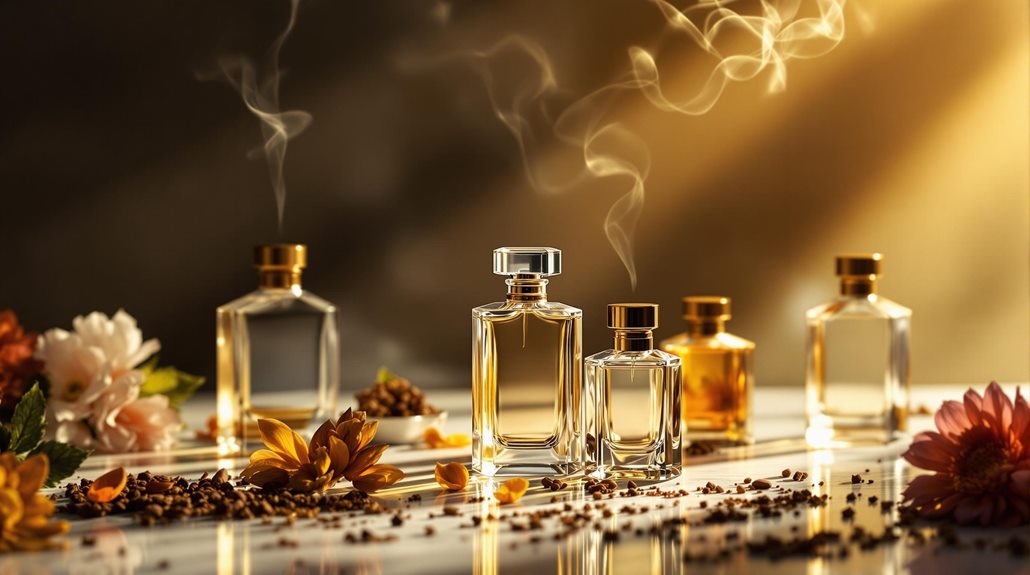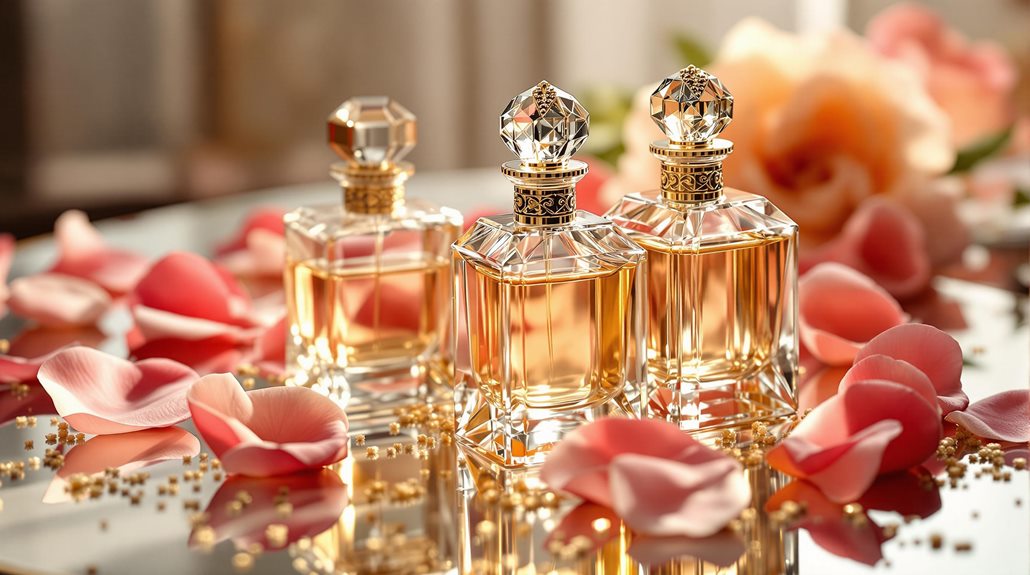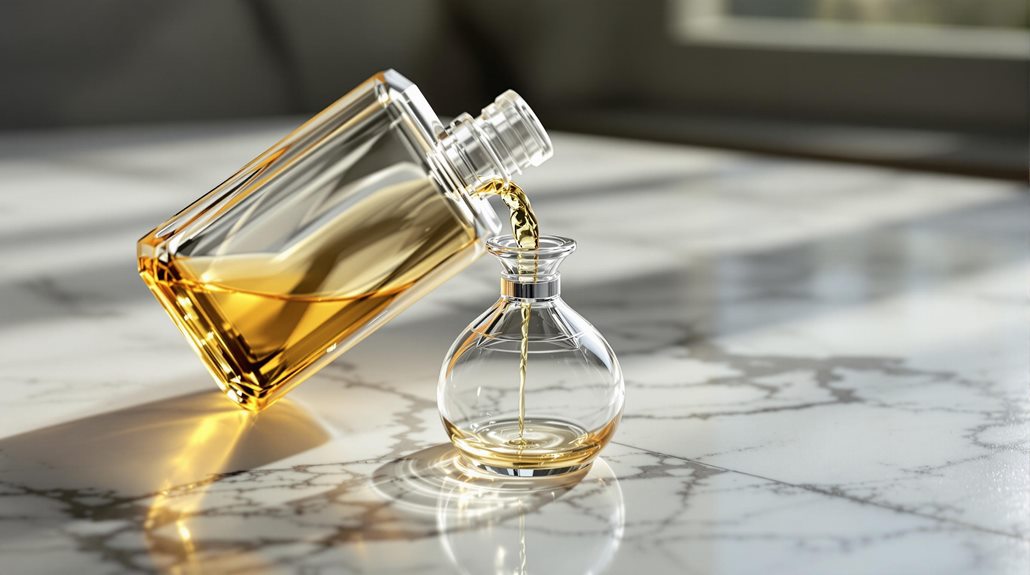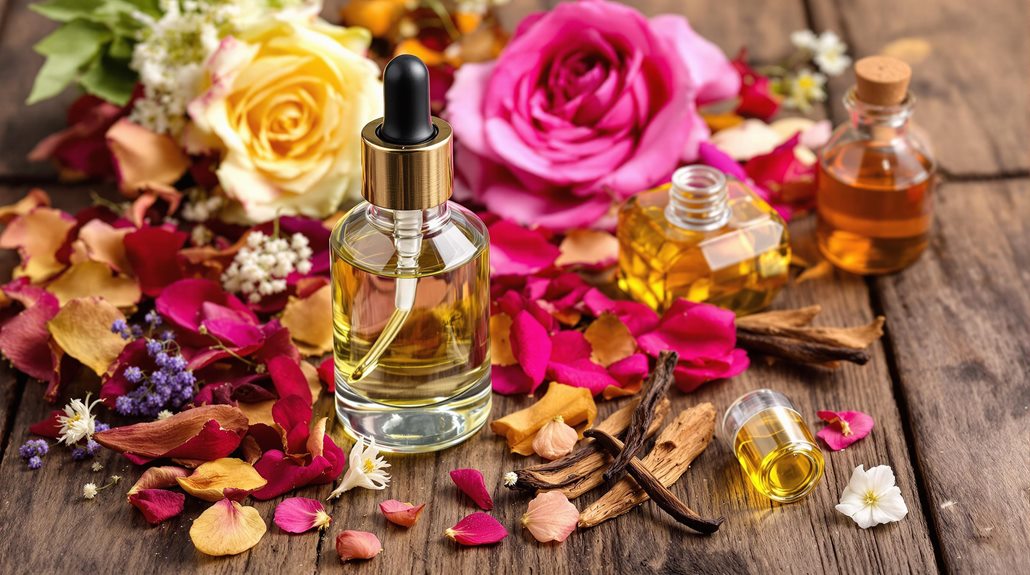What Is Sillage in Perfume? Understanding Fragrance Trail and Strength
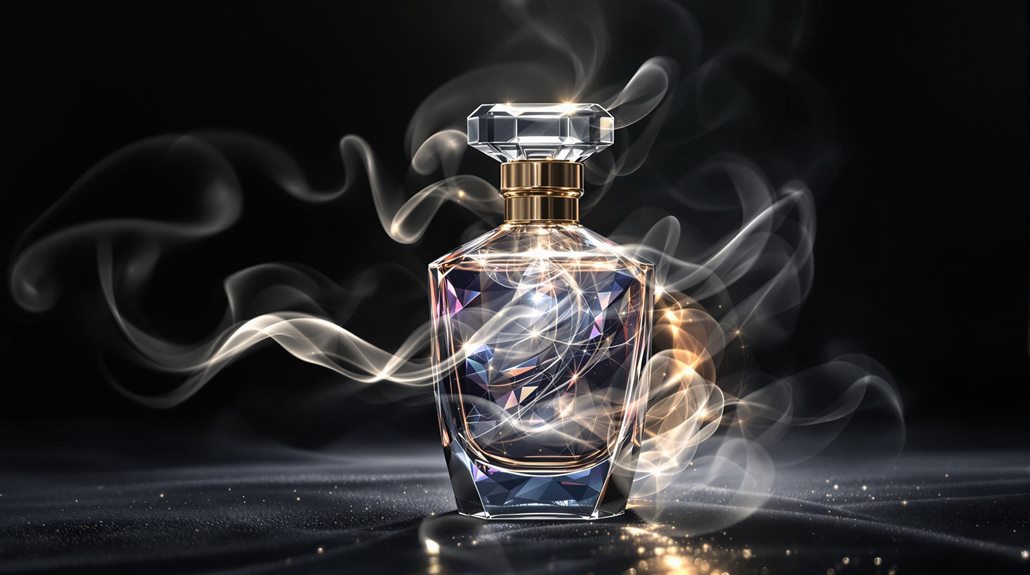
Sillage (pronounced "see-yazh") is your perfume's trail or wake - the scent you leave behind as you move through space. It's different from longevity, as it measures how far your fragrance projects rather than how long it lasts. You'll find that factors like temperature, humidity, and perfume concentration affect your sillage strength. Warmer weather intensifies projection, while cold temperatures create a more subtle scent bubble. Your fragrance notes also play a role, with ingredients like amber, musk, and vanilla creating stronger trails. Understanding these elements will help you command your signature scent's presence.
The Origin of Sillage
In accordance with its French roots, sillage captures the poetic essence of a fragrance's lingering trail. Derived from the French word meaning "wake" or "trail," this term has evolved to become a significant descriptor in the world of perfumery. You'll often hear it pronounced as "see-yazh" in American fashion circles, where it's gained considerable traction in recent years.
When you wear a perfume, you're not just applying a scent - you're creating an invisible signature that follows you throughout your day. This scent trail becomes your personal statement, expressing your mood and personality through carefully crafted fragrance notes. Fashion publications have embraced this concept, helping to establish sillage as an essential element in understanding how perfumes interact with the environment and those around you.
The term serves a practical purpose in helping you choose the right fragrance for different occasions. Understanding sillage allows you to gauge how your perfume will project and diffuse, ensuring you create the desired impact whether you're in an intimate setting or a crowded space.
Measuring Fragrance Trail Strength
Understanding a perfume's sillage involves more than just a casual sniff - it requires a systematic approach to measuring fragrance projection. When you're evaluating a perfume's sillage, you'll encounter a standardized scale from 1 to 10, where 1 represents a whisper-soft fragrance trail, and 10 indicates an intensely powerful scent trail that fills the room.
You'll notice that the concentration of your perfume plays an essential role in its sillage strength. An Eau de Parfum will typically create a more pronounced fragrance trail than an Eau de Toilette. However, don't confuse sillage with longevity - while they're related, they measure different aspects of your perfume's performance.
When you're testing sillage, you'll need to consider environmental factors. If you're in a warm, humid environment, you'll likely experience a stronger scent trail due to increased evaporation. Your skin type will also affect how the fragrance projects - if you have oily skin, you'll typically experience a more prominent sillage as your skin chemistry helps retain and transmit the scent more effectively.
Factors That Impact Sillage
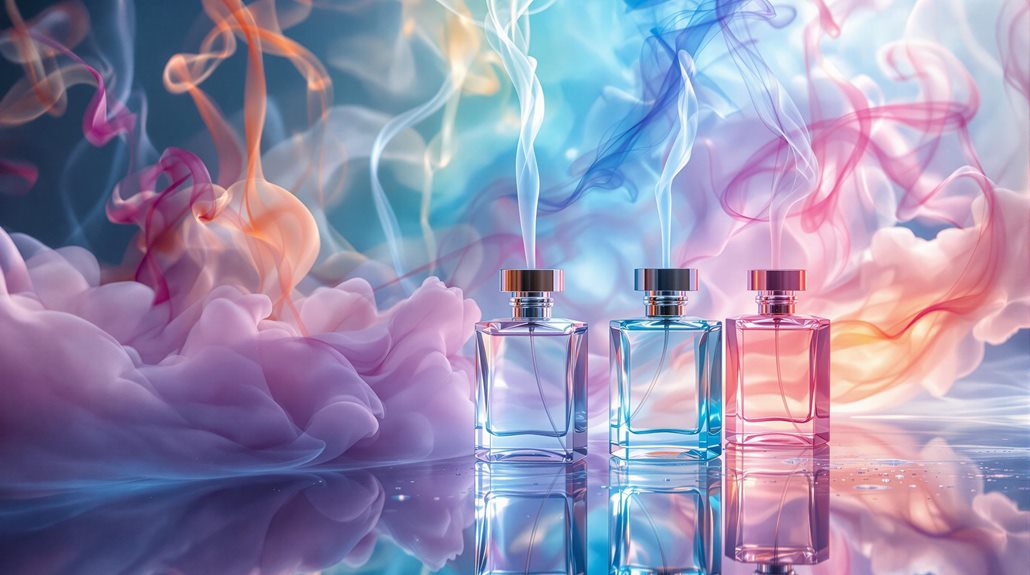
Several key factors shape your perfume's sillage, altering how powerfully it projects into the surrounding air. The type of fragrance notes plays an essential role, as heavy perfume ingredients like amber, musk, and vanilla typically create a more substantial scent trail left behind as you move through space.
Environmental conditions greatly affect how your fragrance performs. In warmer temperatures, your sillage might become more pronounced as heat accelerates the evaporation of scent molecules. Similarly, humidity levels can impact how the fragrance disperses in the air around you.
Your application technique matters too. When you spray perfume directly on your skin, it interacts with your natural body chemistry, potentially creating a different sillage than if you'd applied it to your clothing. Your unique skin chemistry and body oils can either enhance or diminish the fragrance's projection.
The concentration of your perfume is equally important. Higher concentrations, such as parfum formulations, contain more fragrance oils than lighter versions, resulting in stronger sillage. Understanding these factors helps you control how much of a scent signature you're leaving in your wake.
Different Levels of Projection
Fragrances project their scent with varying intensities, from soft whispers that stay close to your skin to powerful clouds that announce your presence before you enter a room. When you're choosing a fragrance, you'll encounter different levels of projection that can shape how others experience your scent.
Light projection fragrances stay close to your body, creating an intimate experience that's only detectable when someone's very near you. These subtle scents leave behind a gentle trail that's perfect for professional settings or close encounters. Medium projection strikes a balance, with a noticeable trail left in your wake without overwhelming those around you.
Strong projection fragrances make a bold statement, filling rooms and lingering long after you've gone. These powerful scents create a significant presence that can be detected from several feet away. You can control your desired level of projection by choosing different fragrance concentrations - eau de toilette typically offers lighter sillage, while parfum provides the strongest projection. Consider your environment and personal style when selecting the right projection level, as what works in one setting may not be appropriate in another.
Weather and Sillage Interaction

Weather plays a key role in how your fragrance projects throughout the day. When temperatures rise, your perfume's sillage becomes more pronounced as the heat accelerates the evaporation of fragrance molecules. This means you'll leave a stronger scent trail in warmer conditions, which might require you to apply less of your favorite eau de cologne during summer months.
In contrast, cool weather slows down the evaporation process, resulting in a more subtle sillage that stays closer to your skin. Humidity adds another layer of complexity, as moisture in the air can help your fragrance project further and last longer than in dry conditions.
Here's how different weather conditions affect your fragrance:
- Hot weather intensifies sillage and requires lighter application
- Cold temperatures create a softer, more intimate scent bubble
- High humidity helps your fragrance linger and project better
- Daily temperature fluctuations can change how much scent trail is left behind
Understanding these weather interactions helps you adjust your perfume application accordingly. You might need more sprays in winter, while summer calls for a lighter touch to achieve your desired sillage effect.
Choosing Your Perfect Sillage
Finding your ideal sillage is a personal expedition that balances your fragrance preferences with social awareness. When selecting your signature scent, you'll need to ponder both the environment where you'll wear it and your desired impact on those around you.
Start by evaluating your daily activities and settings. If you work in close quarters with others, opt for fragrances with lighter sillage that won't overwhelm your colleagues. For evening events or social gatherings, you might choose an eau de parfum with stronger projection that'll last longer and make a more dramatic statement.
Contemplate experimenting with different fragrance concentrations and application methods to achieve your desired effect. Remember that your skin type and local weather conditions will influence how the scent projects and develops throughout the day. What works perfectly in winter might be too intense for summer wear.
If you're unsure about your choices, don't hesitate to seek advice from fragrance experts. They can help you understand how different perfume concentrations interact with your body chemistry and guide you toward options that match your preferred sillage level while remaining appropriate for your lifestyle.
Testing Your Scent Trail

To determine if your fragrance has the right impact, you'll need to evaluate its projection through systematic testing. Just like iconic fragrances such as Mugler's Angel, which is known for its powerful sillage, you'll want to guarantee your scent trail matches your desired effect. Testing your fragrance's projection in different environments will give you valuable comprehension into how it performs throughout the day.
- Spray your fragrance in a room and return after 10 minutes to experience how the scent lingers in the air
- Wear your perfume in both intimate spaces and open areas to understand how it diffuses differently
- Ask trusted friends or family members for their honest feedback about your scent's projection
- Pay attention to both positive and negative reactions from others - if people complain of headaches, you might need to reduce application
Remember that the perfect sillage shouldn't overwhelm others but rather create an inviting scent bubble around you. While some fragrances, like de Nicolaï's creations, are designed for subtle projection, others are meant to make a statement. The key is finding what works best for your personal style and social environment.
Professional Versus Casual Sillage
Once you've commanded testing your fragrance's projection, understanding how to adjust your sillage for different settings becomes your next priority. The French word sillage (pronounced see-yahzh) requires different approaches depending on whether you're heading to the office or stepping out for a social event.
In professional environments, you'll want to leave a subtle scent trail behind that won't overwhelm your colleagues. Light eau de toilette options featuring citrus or gentle floral notes work best for daytime office wear. These fragrances create a pleasant but understated presence that won't distract during meetings or close interactions with clients.
For casual and evening occasions, you can opt for bolder fragrances with more pronounced base notes like musk or vanilla. These create a more noticeable sillage that helps establish your presence at social gatherings. To fine-tune your fragrance's intensity, experiment with different application techniques. Try spraying your clothes instead of your skin for longer-lasting but controlled sillage, or apply fewer spritzes of stronger scents. Remember, the key is matching your fragrance's strength to the setting while maintaining appropriate projection for the occasion.
Common Sillage Mistakes

Many perfume wearers unknowingly commit basic sillage mistakes that can turn their signature scent into an overwhelming presence. When you choose a perfume, you'll want to examine how the fragrance projects and how other people perceive it in different settings.
Common mistakes to avoid include:
- Applying too much perfume because you've become "nose blind" to your signature scent, leading to an overwhelming trail that can disturb others
- Spraying fragrance on clothing instead of pulse points, which can alter how the perfume leaves behind its intended scent trail
- Layering different fragrances without understanding how they'll interact, potentially creating a confusing or unpleasant sillage
- Reapplying perfume throughout the day without letting the previous application fade naturally
To handle your fragrance's sillage, start with one to two sprays on warm body areas like your neck or wrists. Pay attention to how the scent develops throughout the day and adjust accordingly. Remember that your fragrance should invite people closer, not announce your presence from across the room. Examine the concentration of your perfume, as stronger formulations like eau de parfum will naturally project more than lighter options.
Mastering Personal Fragrance Space
Creating your personal fragrance space requires understanding both your perfume's behavior and social awareness. You'll need to think about how your fragrance's top notes initially project and how its heart notes develop throughout the day. This understanding helps you control your sillage effectively in different settings.
To become an expert in your fragrance space, start by testing your perfume's projection in various conditions. Apply it to your pulse points and observe how temperature affects its diffusion. You'll notice that warmer days intensify the scent, while cooler environments may require slightly heavier application. When you want stronger sillage, strategically apply the fragrance to your clothes or hair, but remember that these surfaces hold scents longer than skin.
Always consider your environment when managing your sillage. In close quarters like offices or public transport, opt for subtle application that creates an intimate scent bubble. For social occasions where you want to make a statement, you can increase your fragrance's presence. Pay attention to others' reactions and adjust accordingly – your perfect sillage should enhance, not overwhelm, your presence in any space.
Conclusion
Now that you're equipped with knowledge about sillage, you'll better understand how your fragrance impacts those around you. Remember to match your scent trail to the occasion, consider environmental factors, and test your perfume's projection before wearing it. With practice, you'll become adept at the art of personal fragrance space and avoid common mistakes that can make your scent overwhelming or too subtle.

